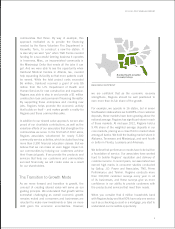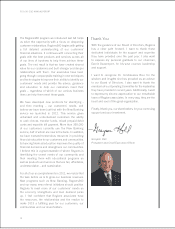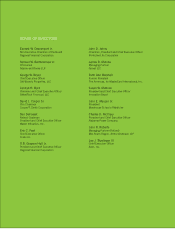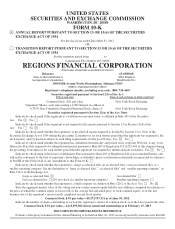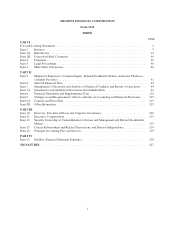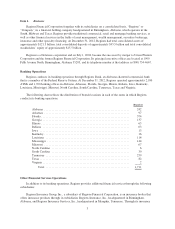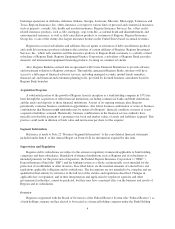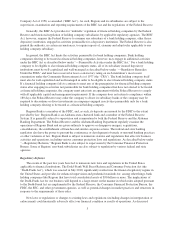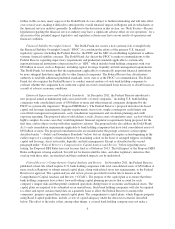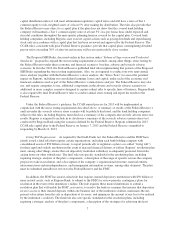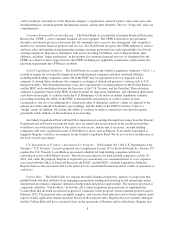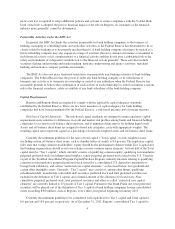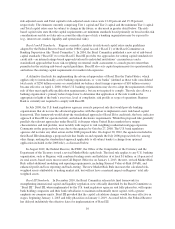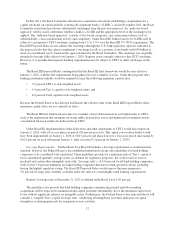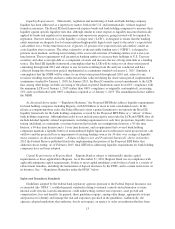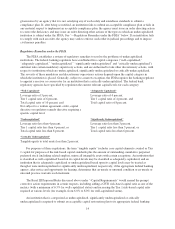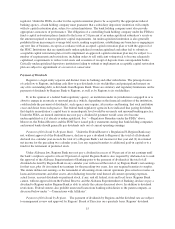Regions Bank 2012 Annual Report Download - page 21
Download and view the complete annual report
Please find page 21 of the 2012 Regions Bank annual report below. You can navigate through the pages in the report by either clicking on the pages listed below, or by using the keyword search tool below to find specific information within the annual report.Company Act of 1956, as amended (“BHC Act”). As such, Regions and its subsidiaries are subject to the
supervision, examination and reporting requirements of the BHC Act and the regulations of the Federal Reserve.
Generally, the BHC Act provides for “umbrella” regulation of financial holding companies by the Federal
Reserve and functional regulation of holding company subsidiaries by applicable regulatory agencies. The BHC
Act, however, requires the Federal Reserve to examine any subsidiary of a bank holding company, other than a
depository institution, engaged in activities permissible for a depository institution. The Federal Reserve is also
granted the authority, in certain circumstances, to require reports of, examine and adopt rules applicable to any
holding company subsidiary.
In general, the BHC Act limits the activities permissible for bank holding companies. Bank holding
companies electing to be treated as financial holding companies, however, may engage in additional activities
under the BHC Act as described below under “—Permissible Activities under the BHC Act.” For a bank holding
company to be eligible to elect financial holding company status, all of its subsidiary insured depository
institutions must be well-capitalized and well-managed as described below under “—Regulatory Remedies
Under the FDIA” and must have received at least a satisfactory rating on such institution’s most recent
examination under the Community Reinvestment Act of 1977 (the “CRA”). The bank holding company itself
must also be well-capitalized and well-managed in order to be eligible to elect financial holding company status.
If a financial holding company fails to continue to meet any of the prerequisites for financial holding company
status after engaging in activities not permissible for bank holding companies that have not elected to be treated
as financial holding companies, the company must enter into an agreement with the Federal Reserve to comply
with all applicable capital and management requirements. If the company does not return to compliance within
180 days, the Federal Reserve may order the company to divest its subsidiary banks or the company may be
required to discontinue or divest investments in companies engaged in activities permissible only for a bank
holding company electing to be treated as a financial holding company.
Regions Bank is a member of the FDIC, and, as such, its deposits are insured by the FDIC to the extent
provided by law. Regions Bank is an Alabama state-chartered bank and a member of the Federal Reserve
System. It is generally subject to supervision and examination by both the Federal Reserve and the Alabama
Banking Department. The Federal Reserve and the Alabama Banking Department regularly examine the
operations of Regions Bank and are given authority to approve or disapprove mergers, acquisitions,
consolidations, the establishment of branches and similar corporate actions. The federal and state banking
regulators also have the power to prevent the continuance or development of unsafe or unsound banking practices
or other violations of law. Regions Bank is subject to numerous statutes and regulations that affect its business
activities and operations, including various consumer protection laws and regulations. As described below under
“—Regulatory Reforms,” Regions Bank is also subject to supervision by the Consumer Financial Protection
Bureau. Some of Regions’ non-bank subsidiaries are also subject to regulation by various federal and state
agencies.
Regulatory Reforms
The events of the past few years have led to numerous new laws and regulations in the United States
applicable to financial institutions. The Dodd-Frank Wall Street Reform and Consumer Protection Act (the
“Dodd-Frank Act”), which was enacted in July 2010, significantly restructures the financial regulatory regime in
the United States and provides for enhanced supervision and prudential standards for, among other things, bank
holding companies like Regions that have total consolidated assets of $50 billion or more. The implications of
the Dodd-Frank Act for our business will depend to a large extent on the manner in which rules adopted pursuant
to the Dodd-Frank Act are implemented by the Federal Reserve, the Consumer Financial Protection Bureau, the
FDIC, the SEC, and other government agencies, as well as potential changes in market practices and structures in
response to the requirements of those rules.
New laws or regulations or changes to existing laws and regulations (including changes in interpretation or
enforcement) could materially adversely affect our financial condition or results of operations. As discussed
5


